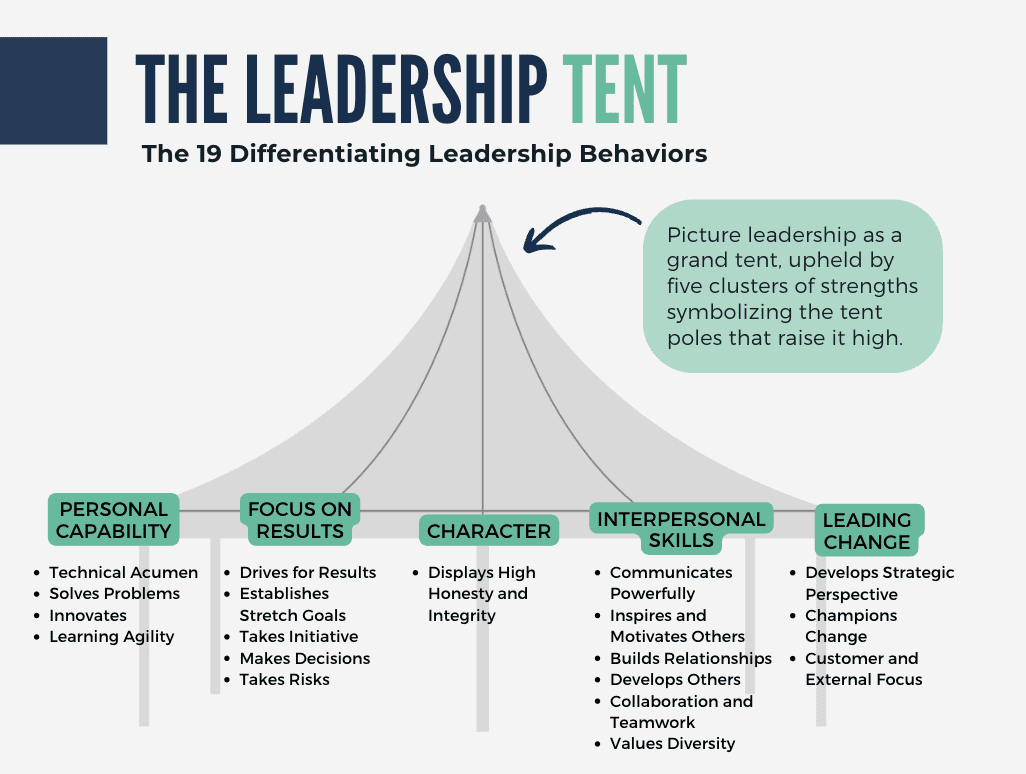Many theories and practices often complicate what can be simplified into an easy-to-understand leadership model. With leadership behaviours intricately woven together, much like the neural pathways of the human brain, the quest for a straightforward leadership model has never been more pressing. Research has illuminated key behaviours that distinguish highly effective leaders from their counterparts, highlighting the need for a balance across various sectors of leadership. Zenger Folkman has developed a leadership tent model, a groundbreaking approach to understanding effective leadership development.
The Five Poles of the Leadership Model
At the heart of the tent model lies a central concept: leaders must exhibit strengths across five distinct sectors. These sectors represent tent poles, with the space inside symbolizing the leader’s effectiveness. This analogy was masterfully explained by Jack Zenger during this podcast episode on the “90th Percentile.”

Source: Zenger Folkman
- Character: The Center Pole
For any leadership model to be effective, character, honesty, and integrity must form its nucleus. As Jack Zenger illustrates, character is defined by:
- Prioritizing the organization over personal agendas.
- Maintaining commitments.
- Treating everyone uniformly.
- Trusting and believing in the good intentions of others.
- Refraining from arrogant behaviours.
The downfall of individuals like Sam Bankman-Fried, the crypto magnate, underscores the dire consequences organizations face when leaders lack these core traits.
- Personal Capabilities
In one corner, this first tent pole represents the personal capabilities of the leader. This pole has several branches: one is technical knowledge and competence, the other is product knowledge and language of the business, and the final element is professional skills. Additional skills in this tent pole are problem-solving, analyzing issues, and innovation, as well as learning agility, which not only includes the ability to be flexible and quick but also includes a willingness to ask for and act on feedback from others. These are the skills that should be acquired early in one’s career before accepting a supervisory position. They are essential to the leader and cannot be passed over.
- Focus on Results
Leaders must exhibit a commitment to achieving tangible outcomes. Five behaviours make up this tent pole, including being results-driven, setting high goals that stretch the team, and accepting responsibility for the workgroup’s performance. It involves taking initiative with new programs, projects, processes, client relationships, or technology. Another crucial skill is the ability to make decisions so the organization can move forward even in the face of ambiguity. And finally, risk-taking, organizations require leaders who are willing to take acceptable risks.
- Interpersonal Skills
Given the obsolescence of the “command and control” leadership styles, today’s leaders must be adept in interpersonal relations. This entails being a strong communicator, motivator, relationship builder, developer, valuer of diversity, and collaborator. This tent pole along with the one in the center supports the most canvas. Interpersonal skills include more differentiating competencies than does any other cluster, and they are the most frequently corrected with all of the other differentiating competencies.
- Leading Organizational Change
With most organizations today in a constant state of change – from dramatic growth to downsizing and restructuring – a critical skill for leaders is leading change. A turbulent business environment puts leaders to the test: excellent leadership can turn a significant shift in a pleasant journey. We know that the best leaders inspire their troops to rally around a change, whereas poor leaders have to push, persuade, or even threaten employees to accept change. They should cultivate a strategic perspective, keep customers at the forefront, and always be tuned to the external world.
The Power of Balanced Strengths in Leadership Development
Strengths are built by utilizing competencies in all tent poles. Some have expressed concern about “overused strengths” – that is, a competency carried to an extreme becoming a weakness. We saw no evidence of overused strengths in the data. Rather, we saw numerous examples of imbalanced strengths that, by themselves, could only take the leader so far. (Imagine how preposterous it would be to tell an executive, “Would you please stop getting such great results? You’re overusing that strength!”)
One tent pole, no matter how tall, doesn’t make a great tent. It lifts very little canvas. Only when the poles are spaced apart, representing differing capabilities, does the tent grow in volume. The easiest way to expand the tent is by extending the poles, not by running about trying to elevate a drooping section of canvas.
A study by Zenger Folkman revealed the power of this balance. Leaders excelling in both ‘Focus on Results’ and ‘Interpersonal Skills’ had an 82% likelihood of being perceived as top-tier. In stark contrast, leaders who mastered only one of these poles had a mere 8-9% chance. This emphasizes the necessity for leaders to spread their competencies, much like the expansive canvas of a tent.
Conclusion: A Leadership Model That Works
The tent model serves as an innovative lens, simplifying the complexity of leadership into an approachable framework. As leaders endeavor to elevate their capacities, the tent model points them towards focused development, ensuring they don’t become “one-trick ponies.”
Optimize your leadership capabilities, balance your strengths, and let the tent model guide your journey towards extraordinary leadership.
About the author
Founded in 2003 by Dr. Jack Zenger and Dr. Joseph Folkman, Zenger Folkman began with three primary objectives to create value for leaders. The first is to discover and share a simple model of leadership and how it can be developed. The second is that the content, findings, and solutions must spark new actions and new behaviours. Lastly, the insistence that insights are based on hard data, facts, and statistical analyses from large sets of data.
Contents of this article remain the property of the author and/or publisher.
 Drive Results in Your Organization
Drive Results in Your Organization